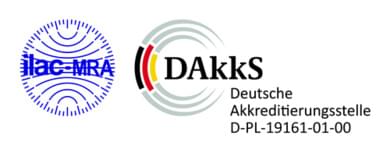Follow-up report: DCONex 2024
In January 2024, the experts in the field of building pollutants met again at DCONex. The fast-growing event was held for the first time this year at the Messe und Congress Centrum Halle Münsterland (MCC) in Münster. The CRB team was once again present at the specialist congress and exhibition. This time not only with its own stand but also on stage: Our colleague Dr. Gunnar Ries moderated the lecture block "Current issues in asbestos analysis" and in this session, our laboratory manager Dr. Stefan Pierdzig gave a lecture on the basics of asbestos analysis.
Of course, we also listened to the other specialist presentations on innovations in the field of asbestos. We have summarized some important topics of DCONex 2024 for you in this follow-up report:
Asbestos analysis: Great interest at DCONex 2024

Many practitioners know little about the processes in laboratories and the problems of analysis. As there was so much interest in the current issues of asbestos analysis, the topic block had to be moved to a larger hall at short notice.
In recent years, there have been more and more new requirements for asbestos analysis, as different asbestos deposits have come into focus. For example, asbestos in road surfaces from 2007 and concealed asbestos products such as tile adhesives, plasters, and fillers from 2015.
How are samples analyzed for asbestos?
In Germany, asbestos is mainly analyzed using a scanning electron microscope and energy-dispersive X-ray microanalysis (SEM/EDX). In France, on the other hand, the transmission electron microscope (TEM) with EDX and possibly electron diffraction is usually used. Depending on the material to be tested, different guidelines and detection limits are relevant and different preparation methods and examination procedures are used.
What types of asbestos fibers are there?
Three types of asbestos fibers can be distinguished according to their properties. The classification can also help with the assessment of so-called geogenic asbestos.
Fiber type A:
- Fibers with a very high length-to-diameter ratio (> 20:1)
- Clearly visible longitudinal splitting and splicing at the fiber ends
- These include fibers with diameters smaller than 1 µm.
- Typical for technically used asbestos fibers (chrysotile, amosite, or crocidolite)
Fiber type B:
- Fibers are usually long-stemmed prismatic with parallel longitudinal edges
- Length-to-diameter ratio of 10:1 to 20:1
- Rarely splitting at the ends
- Frequently amphibolites such as actinolite, tremolite, or anthophyllite
- Usually, find their way into the material as technical additives in construction chemical products or via mineral fillers such as impure marble
Fasertyp C:
- Mostly short-stemmed or short-prismatic asbestos fibers
- Length-to-diameter ratio of 3:1 to 10:1
- Longitudinal splitting is often visible, but no splitting at the often rounded fiber ends
- Typical for amphibole asbestos such as actinolite, tremolite, anthophyllite, and grunerite (amosite)
- Mostly due to mechanical stress from primarily non-fibrous accessory (in the case of amphibolites even rock-forming) asbestos minerals, as found in various basic rocks
Geogenic asbestos in building materials

Asbestos is considered "geogenic" if it has not been intentionally added to building materials to achieve a specific effect. Instead, they are "impurities" of, for example, aggregates in which they occur naturally. Geogenic asbestos usually belongs to fiber categories B or C.
Among the topics discussed at DCONex were the current legal situation regarding geogenic asbestos, the particular challenges for asbestos analysis, and the hazard potential. Much is still unclear here and requires further elaboration.
In which building materials can geogenic asbestos be found?
Geogenic asbestos can occur in basic magmatic rocks such as basalts, diabases, or gabbros. They can also occur in metamorphic rocks, e.g. in serpentinized ultrabasic rocks or in impure marbles formed from limestones with silicate components. If these mineral raw materials are processed, there is a risk that the asbestos trapped in them will be released as respirable fibers.
If these raw materials are used as aggregates for the manufacture of building materials, the asbestos they contain can enter the building products as a "free rider". For example, geogenic asbestos can be found in plasters, tile adhesives, and fillers, but also in PVC floor coverings and other products in which corresponding mineral aggregates are used.
Asbestos fibers can also be released during tunnel construction in the Alpine countries or regions with similar geology. Stonemasons should also protect themselves accordingly when working with natural stone.
Further DCONex topics at a glance
In connection with asbestos analysis, the limits of analysis were also discussed at DCONex 2024. The quality control of laboratories through covert sample dispatch and the use of artificial intelligence in the analysis of asbestos samples were also discussed. Other topics at the specialist congress included:
- News on the Hazardous Substances Ordinance (It is still unclear when this will finally be passed).
- Lowering the asbestos limit values in the workplace
- String remediation in practice
- Remediation of pollutants in listed buildings
- Recycling of carbon and textile concrete
- Legal relationship between client - planner - contractor
If you would like to read more details, we recommend the detailed blog entries by our colleague Dr. Gunnar Ries:
Brief summary of DCONex 2024
The specialist congress on the subject of pollutant management impressed with its pleasant new premises and wide range of topics. Of course, we were particularly excited about asbestos analysis, which was given its own thematic block for the first time. It was fun to share our expertise with the specialist audience as a moderator and speaker and to meet and exchange ideas with visitors at our stand. We are already looking forward to the next DCONex on January 28 and 29, 2025.



